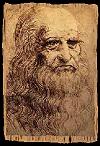|
It was in 1346 that the English first used cannons which, propelled by exploding gunpowder, fired stone balls. Despite this, progress in that area of military weaponry was not fast and it was here Leonardo particularly applied his thinking. This was an area in which there was plenty which could be done to improve the weaponry.
A typical cannon of Leonardo's age was cast iron or bronze, had a short barrel, a short range and fired cannonballs which fitted very approximately. The first thing we know Leonardo did was to design breech-loading cannons as against muzzle-loading. They required a fast means of being cooled before another firing and Leonardo calculated that a vat of water would do the trick. By using several cannons in rotation you could be firing one, loading another and cooling the third. Leonardo was the first to measure the penetrating power of a missile, and to ascertain how to vary it by changing the attitude. During these tests he even managed to launch a rocket-powered cannon-ball ten thousand feet into the air. The steam cannon was another experiment. To be manufactured from copper, the breech of the canon would be built into a brazier of burning coals which would heat it to very high temperatures. Following this, a small amount of water would be injected just behind the iron ball. When the water turned to steam it would drive the ball out under pressure. Given that Leonardo even quoted how large a cannonball this weapon could fire, and how far it would travel, it is quite feasible that this weapon was actually built and test-fired. He wanted to increase the rate of firing weapons and so designed machines with multiple cannons, so they could be fired successively or all together. Many people consider these the forerunner of the modern machine gun. Two of these used racks of eleven or fourteen guns. While the top row was being fired the next rack was loaded; at the same time, a third rack was cooling off. Another design had the guns in a triangle spread for greater distribution of the projectiles. Leonardo also wanted to have more effective projectiles. In attempting to do this he designed shells filled with gunpowder which exploded upon impact; others contained projectiles which would scatter over the area. One design sees a large ball split into two pieces as it leaves the mortar. This sends smaller balls in all directions and they, in turn, explode upon contact. But better projectiles and guns are of little use without a more efficient system of igniting the gunpowder. Leonardo can claim to have invented the wheel-lock, a system which was much more reliable, (and much more expensive) than the flintlock. Centuries after Leonardo's death armies would adopt his system. And now you have your improved ignition system you also need improved gunpowder. Leonardo had favourite recipes for this, including one which had the ingredients dampened and then sun dried. One of Leonardo's most famous drawings is that of a cannon foundry. It shows the manpower, levers, pulleys and tackle required to manipulate the heavy cannons of his time. All the activity in this drawing revolves around the act of placing the cannon onto the gun carriage. |
|

